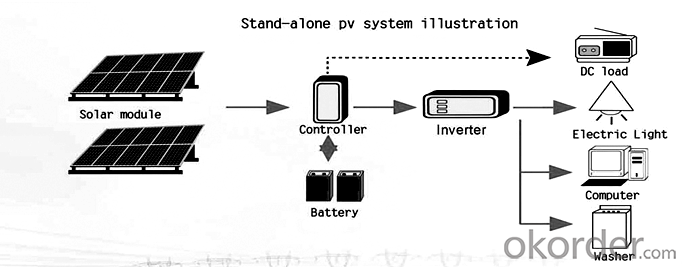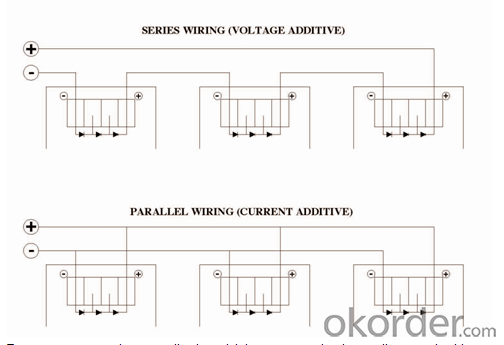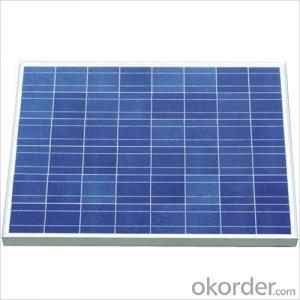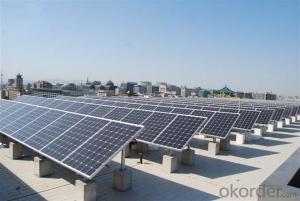295W Solar Panel Silicon Polycrystalline
- Loading Port:
- Nanjing
- Payment Terms:
- TT OR LC
- Min Order Qty:
- 200000 watt
- Supply Capability:
- 20000000 watt/month
OKorder Service Pledge
OKorder Financial Service
You Might Also Like
INTRODUCTION
This installation Manual contains essential information for the electrical and mechanical installation that your must know before installing CUSTOMER PV modules. This also contains safety information you need to be familiar with .All the information described in this manual are the intellectual property of CNBM and based on the technologies and experiences that have been acquired and accumulated in the long history of CUSTOMER. This document does not constitute a warranty, expressed or implied.
CUSTOMER does not assume responsibility and expressly disclaims liability for loss, damage, or expense arising out of in anyway connected with installation, operation, use or maintenance of the PV modules. No responsibility is assumed by CUSTOMER for any infringement of patents or other rights of third parties that may result from use of PV module.
CUSTOMER reserves the right to make changes to the product, specifications or installation manual without prior notice.
WORK PRINCIPLE

COMPONENTS

WIRING
To ensure proper system operation to maintain your warranty, observe the correct cable connection polarity(Figures 1&2) when connecting the modules to a battery or to other modules. If not connected correctly, the bypass diode could be destroyed.
PV modules can be wired in series to increase voltage. Connect wires from the positive terminal of one module to the negative of the next module. Figure shows modules connected in series .

GROUDING
All PV models must be grounded by electrical connection of the module frames to ground. Please be careful in arranging the system ground so that the removal of one module from the circuit will not interrupt the grounding of any other modules.
The modules should be grounded to the same electrical point as described below.
Each PV module has a hole on the side frame of either a bolt, nut and washer grounding the module to the frame, a ground lug fastened by bolt or screw, or appropriate screw(hardware not provided).An example of acceptable ground connection using a bolt, nut and washer retaining a ground lug is shown in figure 3,in a connection of this type, the hardware(such as a toothed locked washer/star washer) must score the frame surface to make positive electrical contact with the frame. The ground wire must be considered within the requirement of local and regulation at the site of installation.


- Q:I have a rental property and use a 230-Volt 6-Amp Pool Pump.I would like to use a solar panel to run it when the house is empty, using mains power when guests are here.The building is in the Caribbean so plenty of sun!!I wanted to run it quot;directand not use batteries. Is this possible??What size panel would I need? A DC invertor too??Thanks!!
- Why don't you use the mains as the battery with net metering. That way you don't have to have two pumps, a DC pump for the solar and an AC pump for the mains. A 230 V, 6 A pump draws 3.68 kw. A typical solar panel produces about 400 watts so you would need about 0 solar panels which should run you about $20,000 US. Of course, you may not need to run the pump continuously but in order to use fewer solar panels for sporadic use, you would need the batteries or the net metering. Keep in mind that with the costs of the panels, you will be paying about 38 cents a kwh. Grid power usually costs around 5 cents a kwh.
- Q:Solar panels would change the world if they were widely available to us especially cheap, it will be worth it in the long end. Money would be saved like housands a year per person on utility costs.
- Down the drain. That money is gone. Just more wasted money the government writes off and then tries to raise taxes to pay for.
- Q:Can solar panels be installed in areas with frequent power outages?
- Yes, solar panels can be installed in areas with frequent power outages. In fact, solar panels can be a great solution for such areas as they generate electricity from sunlight, reducing dependency on the grid. With the addition of energy storage systems, solar panels can provide uninterrupted power supply during outages, making them a reliable and sustainable option.
- Q:i need technical and non technical details to generate MW power by solar panels
- There okorder / Why pay thousands of dollars for solar energy ($27,000 average cost) when you can build your own solar panel system for just a fraction of the retail cost. You can build a single solar panel or you can build an entire array of panels to power your whole house. Some people are saving 50% on their power bill, some people are reducing their bill to nothing. But what’s most impressive is that just by following these instructions some are even making the power company pay them!
- Q:i have a 2v 2a solar panel that i want to use to charge a 2v battery .Have found out that i need a charge controller so i don't over charge the battery.I have found a cheep one its 2v but 7a will it still work ?All-so im planing on running a 2v water pump off the battery with a timer,its for watering my garden.Will the timer have to be 2v as well ?any help on this would be greatly appreciated thanks .
- The charger will accept whatever current is necessary from the solar panel up to 7A. It's not like the solar panel will force 2amps into the charger/battery -- the charger will control the current going to the battery. I question whether or not the 2V panel will actually charge the battery, though, because in order to charge a standard lead-acid 2V battery you need to have about 4.5 volts applied to the terminals. Perhaps the charger has a boost circuit -- I don't know without looking at it or knowing the brand/model number, etc. The timer must be 2VDC, but, if you only have a timer that is rated for 20VAC, you can buy a small inverter that will take 2V and supply the necessary 20VAC. An inverter rated for 20 to 50 Watts should be sufficient. These usually cost under US$25. .
- Q:I have a home made 24 volt electric cart. It is powered by two 2Volt deep cycle batteries. Since the motor runs on 24 volts the batteries are wired in series to produce the 24 volts. I only have a 2 volt battery charger, but I also have two 2 volt solar panels. It is a pain having to unhook wires, rewire it, or charge them one at the time.HERE IS THE QUESTION REALLY... Can I wire the two 2 volt solar panels together in series (ie: negative to positive) then connect it to the existing 24 volt system and have it charge the batteries fine. I know basic wiring, but I know nearly nothing about solar panels, will it work fine? will it cause them to break? or short out?(additional info, the solar panels are only rated at 5 amps so it will not overcharge the batteries or anything)
- Stephen is sweet in you should adventure the enter criteria of your inverter. so that you'll want to cord a minimum of a few cells in series. probable you should custom-go with a blend of series and parallel for the cells. operating example, if maximum of your fragments grant a million amp, then you actual ought to objective a million amp for the array. If there's a fragment that's 0.7 amp, and yet another that's 0.3 amp, you should parallel those, and count number them as one cellular, that you'll then series with the others. I observed this performed on one individual's panel years and years in the past. It gave the impression of an poor mess, and extremely some artwork, because the cells couldn't be in neat rows, anymore. also, if plausible, you should want the utmost equipment voltage you should use, because meaning decrease amperage for an same potential, and to that end smaller cord. 8 amps, after derating, skill #2 or #4 cord, an same variety that must be used to cord your position. 5 amps skill #0 or #8, and one hundred amps skill a fat cord like the jumper cables for a vehicle. in basic terms so that you comprehend, i trust that's typically unlawful contained in the U. S. to connect a selfmade array to a grid-tied equipment, or to apply a grid-tied inverter that plugs into the wall socket, in case you care.
- Q:Ok, so I've been having much success with the joule thief circuit and a LED, but i tried hooking it up to a small solar panel that can put out 2.5v on it's own, and can light up a white LED dimly by it self to the joule thief and it will not work ....my question is why? I already trouble shooted it, the circuit is not the problem, is it the amount of amps the small solar panel is capable of? not enough?
- Solar panels convert light energy to electrical energy with an efficiency of around 5%. A SMALL solar panel will only produce a small amount of power (watts) your joule thief circuit wont help because as you draw more current from the solar panel the voltage will drop; and your joule thief circuit just reduces the efficiency of the whole system Try adding another solar cell in series to get more voltage and more power.
- Q:The intensity of sunlight at the distance of the Earth's orbit is 380 W/m2. An Earth-orbiting satellite has a solar panel that measures .35 m by 4.86 m, which converts solar energy to electrical energy with an efficiency of 26%. In one hour, how much electrical energy does the panel produce? Assume that the satellite's attitude control jets keep the panel oriented perpendicular to the incoming sunlight.
- 380 W/m2. An Earth-orbiting satellite has a solar panel that measures .35 m by 4.86 m, which converts solar energy to electrical energy with an efficiency of 26%. In one hour, how much electrical energy does the panel produce? 380 W/m? x .35 m x 4.86 m x 0.26 = 2354 watts energy is watts*time E = 2354 watts x 3600 sec = 847472 Joules or, E = 2354 watt-hours
- Q:For my exam in science we are required to make a power point explaining why it would be good for our school to switch to solar. our complete handout given to us by our teacher is as follows:Power Point to include:. What you propose for alternative energy usea. Any thoughts on energy conservation...2. Why this is a good idea3. What information you would give the solar company (area of roof space your group determined to be useable for solar)In PowerPoint - include your quot;scriptof what you would be saying when the slide is up in the Notes section below the slideANY HELP WOULD BE GREATLY APPRICIATED!!THANK YOU SO SO MUCH,QH
- Energy conservation Use sensors that turn of lights and unneccassary equipment when person leaves the premises 2) Saves hard earned energy 3) Area of roof space depends on how much energy you want to collect from the sun.
- Q:I need a solar panel for my laptop as i am going camping in the desert, and i need my laptop. There are two choices of solar panels, One is 0 watts and 2 V and maximum power current 0.56 amps. The other one is 2 watts, 2 V and no mention of current. My laptop plug says input 00-240V and .5A and then output 5V-5A. Which one should i get for my laptop. If there are other choices please tell me ill look them up on OKorder.Thanks
- I'm afraid neither of these panels will do much for charging or running your laptop. If the power brick is supposed to emit 5 volts at 5 amps, that's 75 watts. Neither of those panels provides enough voltage and the power output is obviously far too small. The capabilities of solar power are vastly overestimated for small panels. Sunlight is limited to about kilowatt per square meter under ideal conditions (summer time, clear blue sky, for a few hours around noon in the US southwest). But consumer panels top out at about 5% efficiency, so your limit is 50 watts per square meter - in other words you would need about half a square meter, or about six square feet, of panel to provide 75 watts. And even under ideal conditions you will only get that much for a few hours each day. Also, the panel's voltage output is not regulated, so even if you find a panel that emits 5 volts (this would actually have to be made up of groups of 30 cells in series, as they emit half a volt each at most) you can't just connect the panel output into your laptop's DC in. You'd need a regulated DC-to-DC supply, and since that is not 00% efficient it will cost a bit of the power... now you need even more panel area. All in all, not really a practical thing to carry along on a camping trip.
1. Manufacturer Overview |
|
|---|---|
| Location | |
| Year Established | |
| Annual Output Value | |
| Main Markets | |
| Company Certifications | |
2. Manufacturer Certificates |
|
|---|---|
| a) Certification Name | |
| Range | |
| Reference | |
| Validity Period | |
3. Manufacturer Capability |
|
|---|---|
| a)Trade Capacity | |
| Nearest Port | |
| Export Percentage | |
| No.of Employees in Trade Department | |
| Language Spoken: | |
| b)Factory Information | |
| Factory Size: | |
| No. of Production Lines | |
| Contract Manufacturing | |
| Product Price Range | |
Send your message to us
295W Solar Panel Silicon Polycrystalline
- Loading Port:
- Nanjing
- Payment Terms:
- TT OR LC
- Min Order Qty:
- 200000 watt
- Supply Capability:
- 20000000 watt/month
OKorder Service Pledge
OKorder Financial Service
Similar products
New products
Hot products
Related keywords




























